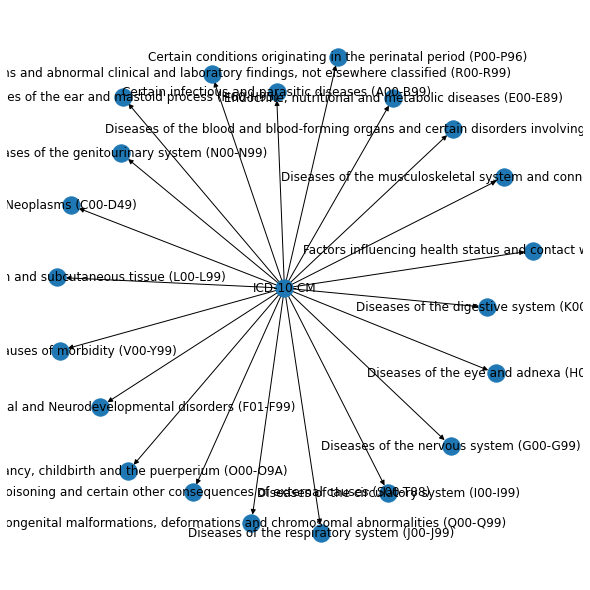Usage
networkx Hierarchy
The International Classification of Disease seperates diseases into chapters, subchapters and so on. icdcodex considers each of these as a node in a network – and provides access to this representation through networkx.
from icdcodex import hierarchy
icd_10_cm_hierarchy, icd_10_cm_codes = hierarchy.icd10cm("2020")
The network is unstructured, by default. But we can use networkx to do graphical analysis. For instance, we can generate a spring layout of the chapters using breadth first traversal.
import networkx as nx
from networkx.algorithms.traversal.breadth_first_search import bfs_tree
import matplotlib.pyplot as plt
G = nx.relabel_nodes(icd_10_cm_hierarchy, {"root": "ICD-10-CM"})
G_chapters = bfs_tree(G, "ICD-10-CM", depth_limit=1)
plt.figure(figsize=(8,8))
nx.draw(G_chapters, with_labels=True)

Vector Embeddings
icdcodex uses this graphical structure to build a dense representation of individual codes. So far, we provide the node2vec algorithm, accessible through the icd2vec module.
from icdcodex import icd2vec, hierarchy
# workers=-1 parallelizes the node2vec algorithm across all available CPUs
embedder = icd2vec.Icd2Vec(num_embedding_dimensions=2, workers=-1)
embedder.fit(*hierarchy.icd9())
Dense representations have the property that similar vectors have similar locations in vector space. For example, 033.0 (Whooping cough due to bordetella pertussis) and 034.0 (Streptococcal sore throat) are both bacterial diseases. 910.1 (Abrasion or friction burn of face, neck, and scalp except eye, infected) is an injury. We expect 034.0 and 033.0 to be closer to one another than to 910.1
codes_of_interest = ["0330", "0340", "9101"]
codes_of_interest_continuous = embedder.to_vec(codes_of_interest)
codes_of_interest_continuous
array([[ 0.78746617, -1.1355207 ],
[ 0.7202955 , -0.97387433],
[ 5.667383 , -0.13091612]], dtype=float32)
Example: Predicting MIMIC-III diagnostic codes
For a more involved example, we’ll build a scikit-learn pipeline. To get our data, we’ll use MIMIC-III. A demo version can be accessed through the GCP Big Query service by running ADD DATA > Pin a project > Enter a project name > physionet-data. Run the SQL query:
SELECT
i.seq_num, i.subject_id, i.icd9_code, j.los, k.gender, k.dob, k.dod, l.admittime
FROM `physionet-data.mimiciii_demo.diagnoses_icd` as i
INNER JOIN
`physionet-data.mimiciii_demo.icustays` as j
ON i.hadm_id = j.hadm_id
INNER JOIN
`physionet-data.mimiciii_demo.patients` as k
ON i.subject_id = k.subject_id
INNER JOIN
`physionet-data.mimiciii_demo.admissions` as l
ON i.hadm_id = l.hadm_id
Then, save the results as data.csv.
First, we’ll import boilerplate data science libraries
import pandas as pd
from sklearn.model_selection import train_test_split
Then, load the data and do feature engineering to give the model something with which to predict ICD codes.
df = pd.read_csv("data.csv").rename(columns={
"los": "length_of_stay",
"dob": "date_of_birth",
"dod": "date_of_death",
"admittime": "date_of_admission"
})
df["date_of_birth"] = pd.to_datetime(df["date_of_birth"]).dt.date
df["date_of_death"] = pd.to_datetime(df["date_of_death"]).dt.date
df["date_of_admission"] = pd.to_datetime(df["date_of_admission"]).dt.date
df["age"] = df.apply(lambda e: (e['date_of_admission'] - e['date_of_birth']).days/365, axis=1)
df = df[df.seq_num == 1] # we limit ourselves to the primary diagnosis code for simplicity
df.gender = LabelEncoder().fit_transform(df.gender)
G, icd_codes = hierarchy.icd9()
df = df[df.icd9_code.isin(G.nodes())]
features = ["length_of_stay", "gender", "age"]
X = df[features].values
y = df[["icd9_code"]].values
X_train, X_test, y_train, y_test = train_test_split(X, y, test_size=0.2, random_state=42)
Now, we can use any regression model that can predict a vector, including RandomForestRegressor
from sklearn.ensemble import RandomForestRegressor
y_train_continuous = embedder.to_vec(y_train.reshape(-1))
clf = RandomForestRegressor()
clf.fit(X_train, y_train_continuous)